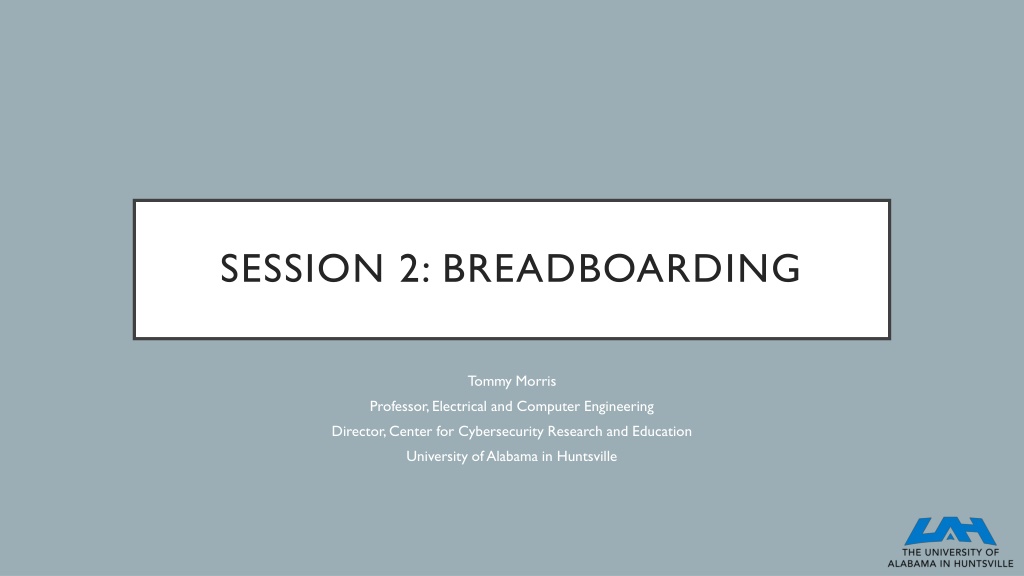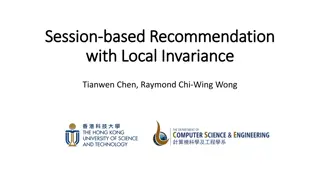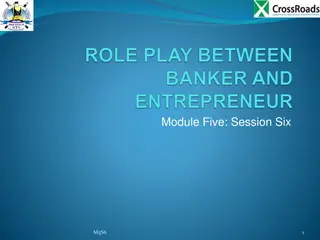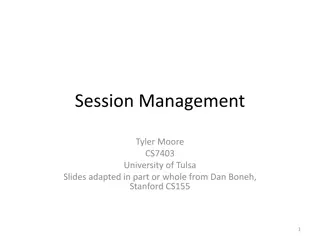SESSION 2: BREADBOARDING
Explore breadboarding basics with the Elegoo Uno Project Basic Starter Kit, including components like Arduino Uno, USB cable, resistors, wires, power connections, and examples of short circuits. Learn about wire types, power, ground connections, and resistor sizing in this comprehensive guide to getting started with electronics projects.
Download Presentation

Please find below an Image/Link to download the presentation.
The content on the website is provided AS IS for your information and personal use only. It may not be sold, licensed, or shared on other websites without obtaining consent from the author.If you encounter any issues during the download, it is possible that the publisher has removed the file from their server.
You are allowed to download the files provided on this website for personal or commercial use, subject to the condition that they are used lawfully. All files are the property of their respective owners.
The content on the website is provided AS IS for your information and personal use only. It may not be sold, licensed, or shared on other websites without obtaining consent from the author.
E N D
Presentation Transcript
SESSION 2: BREADBOARDING Tommy Morris Professor, Electrical and Computer Engineering Director, Center for Cybersecurity Research and Education University of Alabama in Huntsville
ARDUINO Arduino is a family of single board computers. Arduino is an opensource hardware and software company. Many companies manufacture Arduino boards. Not all are created equal. At UAH, we have had good experience with Elegoo. The board and kit used for this class is the ELEGOO UNO Project Basic Starter Kit with Tutorial and UNO R3 for Arduino Available on Amazon.com for $16.99 (May 29, 2019) https://www.amazon.com/Elegoo-EL-KIT-004-Project-Starter-Tutorial/dp/B01DGD2GAO
ELEGOO UNO PROJECT BASIC STARTER KIT WITH TUTORIAL AND UNO R3 FOR ARDUINO Arduino Uno USB Cable Breadboard 5 buttons 25 LED 120 resistors (various sizes) 65 male to male jumper wires 5 male to male to female wires 2 photo resistors 1 tilt switch 1 74HC795 (8-bit shift register) Buzzer Tutorial CD
BREADBOARD CONNECTIVITY short circuit examples Rows are labeled 1,2,3, ,30 Columns - labeled a,b,c, ,j All pinholes on the same row in columns a-e are short circuited to one another All pinholes on the same row in columns f-j are short circuited to one another + and - rails are available on the left and right sides of the board. For each side (left and right) all rows of the + column are short circuited to one another For each side (left and right) all rows of the - column are short circuited to one another The left and right sides are not connected to each other
WIRES Wires are short circuits. Wires have 0 ohms resistance. We use wires to connect Arduino pins to the breadboard and to connect breadboard cells to one another. The wires in the kits are also known as Dupont wires. There are two types in the kits male-to-male and male-to-female.
POWER AND GROUND Power is the positive voltage. Generally, power uses a black wire. The Arduino Uno has 2 power rails 3.3V 5V Ground (aka. gnd and common) is the negative voltage. Connect the 3.3V pin on the Arduino to the + rail on the bread board. Connect the GND pin on the Arduino to the - rail on the bread board. Note: There to GND pins. Use either one. They are short circuited together on the Printed Circuit Board (PCB). Use Dupont wires to connect the left and right + rails to one another. Repeat for the two - rails.
SIZING RESISTORS The resistors in the Elegoo kit have 5 color bands. Use the table to calculate resistance values. or Use the calculator here https://www.digikey.com/en/resources/conve rsion-calculators/conversion-calculator- resistor-color-code-4-band or Use the label on the tape holding the resistors or Use a multimeter to measure the resistance. or Use an app
WHAT IS A RESISTOR? Resistors limit current. They limit the number of electrons that can pass through a medium. Resistors are measured in units of Ohms. Ohms law states: Arduino has 2 voltages: 3.3V and 5V. These don t change. V = RI : Voltage (V) = Resistance (R) * Current (I) For a given (constant) voltage, as resistance increases current decreases. Resistance is also known as impedance. For DC (Direct Current) circuits resistance and impedance are the same. Resistance is abbreviated R and impedance Z.
RESISTOR SYMBOLS Sometimes resistors are labeled R1, R2, ... (or Z1, Z2, ) Sometimes resistors are labeled with values.
BUTTONS Push button switches Buttons are normally open circuits. when open (not pressed) This means there is infinite resistance across the terminals The terminals are electrically isolated from one another When pressed the circuit is closed when closed (pressed) This means the there is 0 resistance across the terminals The terminals are electrically short circuited to another
RESISTOR USE CASES Advanced: Output pins can also use pull-ups/downs when the pin is tri-stated. Pull-ups and pull-downs These are large resistors connected between input pins and a power rail. Pull-downs connect the pin to GND. Pull-ups connect the pin to the positive voltage rail. Use when the input pin is not normally connected to a power rail or driven in some way. This ensures the input pin is not. Some chips have internal pull-ups/pull-downs. Arduino I/O pins do not.
PULL DOWNS FOR SWITCHES When pressed there is a voltage divider with Z1 = 0, Z2 = 10K. R1 and R2 are pull-downs. PB1 and PB2 are switches. When pressed (PB1 or PB2), the pin (%IX0.0 and %IX0.1) is short circuited to +V. Since the button short circuit has 0 Ohm resistance the pin goes to +V when the button is pressed. When not pressed, the pull-downs pull the voltage to 0V (GND). Use a 10K Ohm resistor for R1 and R2.
RESISTORS FOR LEDS Forgetting the resistor will burn the LED. Resistors can be used to limit current flow. Use a 1K-10K Ohm resistor. Using larger resistors will dim the brightness of the LED (by decreasing the current). Typical datasheet https://www.sparkfun.com/datasheets/Components/YSL-R596CR3G4B5C-C10.pdf
LED Light Emitting Diode (LED)

























